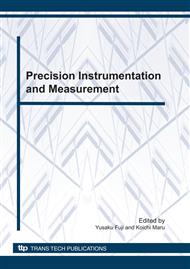[1]
Jiang B Y: Applied near zone magnetic source transient electromagnetic exploration. Beijing: Geological publishing house, 1998, 1-5.
Google Scholar
[2]
Du Q F, Guan Z N., and He Zh M: Discussion on TEM data pretreatment method. Geophysical & geochemical exploration, 2006, 30(1): 67-70.
Google Scholar
[3]
Guo W B, Song J P, and Han J M. et al: A new rapid interpretation method for central-loop-source transient electromagnetic detection. Geophysical & geochemical exploration, 2006, 30(2): 154-161.
Google Scholar
[4]
Xu S Z, Yu T, and Li Y G. et al: The finite element method for modeling 2D MT field on a geoelectrical model with continuous variation of conductivity within each block(I). Geological journal of universities, 1995, 1(2): 65-73.
Google Scholar
[5]
Chen L S, Liu R, and Wang T S: Data processing and interpretation for MT sounding. Beijing: Petroleum industry publishing house (1989).
Google Scholar
[6]
Ruan B Y, and Xu S Z: FEM for modeling Resistivity sounding on 2D geoelectric model with line variation of conductivity with each block. Earth science, 1998, 23(3): 303-307.
Google Scholar
[7]
Misac, N Nabighian: Electromagnetic methods in applied geophysics, Vol. 1: Theory: Translated by Zhao Jing-xiang. Beijing: Geological publishing house (1992).
Google Scholar
[8]
Everett M E, Edwards R N: Transient marine electromagnetics: the 2. 5-D forward problem. Geophys. J. Int., 1992, 113: 545-561.
Google Scholar
[9]
Luo Y Z, and Zhang G. Q: Application of electronic computer in electrical prospecting. Wuhan : Wuhan college of geology publishing house, 1987, 51-99.
Google Scholar
[10]
Xu S Z: FEM in geophysics. Beijing: Science publishing house (1994).
Google Scholar
[11]
Mitsuhata Y, 2-D electromagnetic modeling by finite-element method with a dipole source and topography. Geophysical, 65(2): 465-475.
DOI: 10.1190/1.1444740
Google Scholar
[12]
Wang H J: Methods study on 2. 5D forward and inversion for transient electromagnetic with central loop: Ph. D. thesis. Wuhan: China university of geosciences, (2001).
Google Scholar
[13]
Shen J S: Modeling of 3D electromagnetic responses to the anisotropic medium by the edge finite element method. Well logging technology, 2004, 28(1): 11-15.
Google Scholar
[14]
Niu Z L: The theory of time-domain electromagnetic methods. Changsha: Central south university of technology publishing house, (1992).
Google Scholar
[15]
Luo Y Z, and Chang Y J: A rapid algorithm of G-S transform. Chinese Journal of Geophysics, 2000, 43(5), 684-690.
Google Scholar


